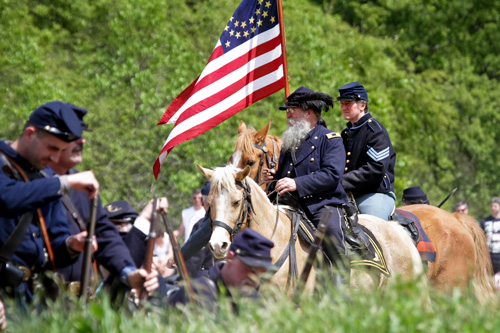The Battle of Lee’s Mill in Newport News

On May 24, 1861, Confederate Colonel John Magruder assumed command of the Virginia Peninsula’s defenses. The Confederate capital at Richmond was only 80 miles from Fort Monroe. Consequently, “Prince John” Magruder – known for his flair and style in dress and manner on and off the battlefield – fortified points along the James and York rivers to block any Union advance toward Richmond.
From local reconnaissance, including assistance from Richard D. Lee of Lee Hall Mansion who owned a grist mill on the Warwick, Magruder laid out three lines of fortifications:
1. The first defensive line went from Young’s Mill on Deep Creek across the Peninsula to Ship’s Point on the Poquoson River.
2. The second line stretched from Mulberry Island, followed the swampy Warwick River to within one mile of Yorktown, and linked with the fortifications around the old colonial tobacco port.
3. The third line consisted of 14 redoubts between College and Queen’s creeks, only a few miles in front of Williamsburg.
The Warwick-Yorktown Line was the main line of resistance with the Confederates adding three dams to the Warwick River, which created an almost impassable barrier. There were already two antebellum grist mill dams at Lee’s Mill and Wynne’s Mill. Magruder’s June 10, 1861, victory at the Battle of Big Bethel bought the Confederate commander time needed to erect his defenses and, ultimately, a promotion to major general.
From the summer of 1861 through spring 1862, Confederate soldiers and slaves dug defenses across the Peninsula. Magruder especially concentrated his efforts at Lee’s Mill where the Great Warwick Road crossed the Warwick on the grist mill dam. The Confederates cleared the timber off the riverbanks for a good field of fire and dug complex fortifications guarding this section of the Warwick-Yorktown Line. As Magruder expected, the Federals made their move in early 1862.
In March 1862, Union Major General George McClellan’s Army of the Potomac landed on the tip of the Virginia Peninsula at Fort Monroe and Camp Butler. In three weeks, a flotilla of 389 vessels transported 121,500 troops, 101 heavy siege guns, 44 field artillery batteries, 14,592 animals, 1,150 wagons, and other equipment for this massive operation. The Union commander’s goal was the capture of Richmond, which he hoped would end the Civil War.
General Magruder, who only commanded 13,000 troops, rightly viewed this situation with alarm, flooding the Confederate War Department with telegraphs requesting more artillery and troops for the Peninsula’s defenses; however, Magruder’s flair for the dramatic coupled with McClellan’s own innate, almost pathological, caution helped even the odds.

On April 4, 1862, the Army of the Potomac moved up the Peninsula in two columns. The III Corps marched from Fort Monroe up the Hampton-Yorktown Highway toward the Yorktown defenses, and the IV Corps advanced up the Great Warwick Road from Camp Butler toward the Halfway House between Yorktown and Williamsburg.
General McClellan planned to trap the Confederates in a two-prong maneuver with the III Corps holding Magruder’s forces at Yorktown while the IV Corps blocked their retreat toward Williamsburg. This was a solid plan, but the Union maps were based on earlier colonial or French maps which incorrectly showed the Warwick River flowing parallel to the James River.
McClellan was unaware that the Warwick River was actually formed near Yorktown and flowed across the Peninsula for several miles before turning east emptying into the James River. The Warwick River was a natural barrier that the Confederates had expertly exploited and would prove the undoing of McClellan’s careful plans. Lee’s Mill proved a wise investment in energy on the part of the Confederates.
On April 5, 1862, Brigadier General William “Baldy” Smith’s division led the IV Corps’ advance from Young’s Mill past the Warwick Courthouse toward Lee’s Mill. Brigadier General Lafayette McLaws’s brigade, supported by Captain Joseph Cosnahan’s Peninsula Artillery, defended Lee’s Mill.
Baldy Smith’s division was blocked by the Warwick River and the Confederate defenses. Lieutenant Colonel John Weems marched four companies of the 10th Georgia Infantry over duckboards across the Warwick to skirmish with the advancing Union soldiers. Moreover, Captain Cosnahan’s two cannons on the extreme right dueled with Captain Charles Wheeler’s Battery E, 1st New York Light Artillery and forced their withdrawal.
Halted by the Confederate defenses, General Smith deployed his three brigades under heavy fire along the Warwick. Brigadier General Erasmus Keyes, who commanded the IV Corps, reported to McClellan that “No part of this line as far as discovered can be taken by assault without an enormous waste of life.” The Battle of Lee’s Mill only cost the Confederates seven casualties and the Union 12, but had larger strategic implications.
The Battle of Lee’s Mill set the stage for an elaborate ruse as General Magruder maneuvered his troops along the 12-mile front and created the illusion of double his numbers. Moreover, General McClellan was daunted by the extensive Confederate defenses. Little Mac believed that he was facing a superior enemy force and besieged the Warwick-Yorktown Line.
Between April 5 and May 4, 1862, the Federals constructed 15 separate batteries for mounting the siege cannons and mortars necessary for blasting through the Confederate defenses near Yorktown. Magruder’s theatrics allowed General Robert E. Lee and the War Department time to gather enough men and material to adequately defend Richmond, while McClellan’s men wasted their time with endless digging in foul weather and skirmishing with a skeleton force.
By the time of the Confederate retreat on the night of May 3, 1862, General Lee had directed the construction of defensive lines around Richmond coupled with fortifying Drewry’s Bluff on the James River. McClellan had lost the tactical advantage of his bold amphibious landing by not vigorously pressing Magruder, and he earned the sobriquet of the “Virginia Creeper” for advancing so slowly toward the Confederate capital.
Moreover, McClellan again surrendered the initiative to Lee during the Seven Days Battles and failed to capture Richmond. The Civil War would continue another three years costing more than 620,000 American lives.


